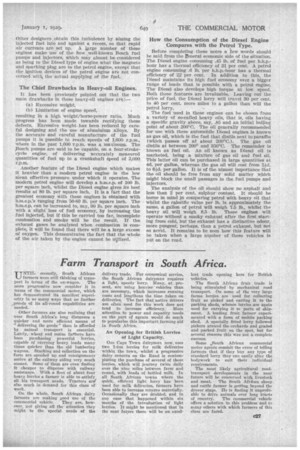Farm Transport in South Africa.
Page 11

If you've noticed an error in this article please click here to report it so we can fix it.
UNTIL recently, South African farmers were still thinking of transport in terms of the ox-wagon. The more progressive now consider it in terms of the commercial motor, which has demonstrated its manifest superiority in so many ways that no further proofs of its all-round capabilities are needed.
Other farmers are also realizing that Over South Africa's long distances a quick.er and more efficient means of "delivering the goods" than is afforded by animal transport is essential. Lately, wheat and maize Ruiners have been purchasing powerful lorries, capable of carrying heavy loads many times quicker than the old lumbering wagons. Stacking and collection on the farm are speeded up and consignments arrive at the railway siding very much sooner. Some of them are even finding it cheaper to dispense with railway assistance. With a fleet of about four heavy lorries a farmer is able to satisfy all his transport needs. Tractors and also much in demandfor this class of work.
On the whole, South African dairy farmers are making good use of the
commercial vehicle. They are, however, not giving all the attention they might to the special needs of the
delivery trade. For economical service, the South African dairyman requires a light, speedy lorry. Many, at present, are using heavier vehicles than are necessary, which increases running costs and lengthens the time taken on deliveries. The fact that native drivers are often used for this work does not tend to increase efficiency. More attention to power and capacity needs on the part ol agents would do much to popularize this important farming aid in South Africa.
An Opening for British Lorries of Light Capacity.
One Cape Town dairyman now, uses two 1-ton lorries for milk deliveries within the town, whilst a progressive dairy concern on the Rand is contemplating the purchase of several of these lorries, which will journey twice daily over the nine miles between farm and round, -with loads of bottled milk. In all South African towns where the quick, efficient light lorry has been used for milk deliveries, farmers have been able to increase returns materially. Occasionally they are doubled, and in one case that happened within six months of the introduction of light lorries. It might be mentioned that in the near future there will be an excel
lent trade opening here for British vehicles.
The South African fruit trade is being stimulated by mechanical road transport. On some of the very large farms lorries are used for collecting fruit as picked and carting it to the packing sheds, whence lorries are again used for carrying it to ports of shipment. A leading fruit farmer experimented with a form of mobile packing shod. A specially fitted lorry followed pickers around the orchards and graded and packed fruit on the spot, but for several reasons this was not a complete success.
Some .South African commercial motor agents commit the error of telling farmers that if they buy any type of standard lorry they can easily alter the bodywork to suit their individual requirements.
The most likely agricultural roadtransport developments in the near future will be concerned with livestock and meat. The South African sheep and cattle farmer is getting beyond the drover stage. He 18 finding it unprofitable to drive animals over long tracts
of country. The commercial vehicle offers a solntion to this problem and to many others with which farmers of this class are faced.
















































